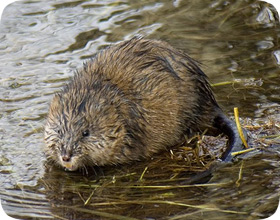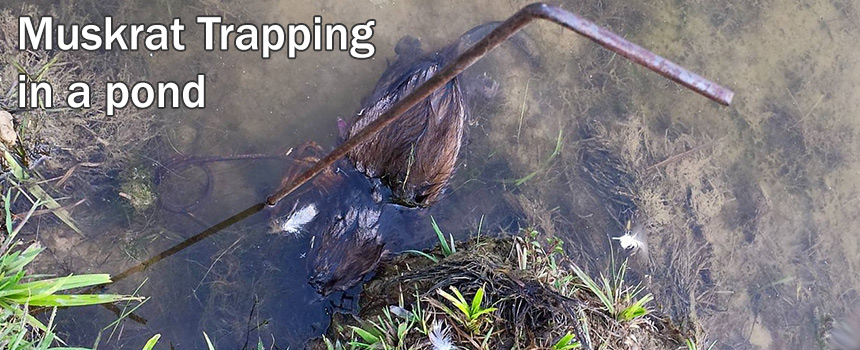-
info@aaanimalcontrol.com
Call us for help in your town
Humane Wildlife Education
How to Get Rid of Muskrats
We are experts in muskrat control methods, having performed thousands of muskrat trapping and removal jobs nationwide.
 Talk about being able to adapt to a wide range of climates; muskrats are one of the most adaptable creatures around. Muskrats are sometimes mistaken as rats because of their diet & lifestyle.
They have short, thick fur that ranges in colors from brown to black. Their bellies are a little lighter than their fur but it tends to turn a grayish color as they age. They survive well in cold
temperatures because of the two layers of fur on their bodies and they have a long tail that assists them in swimming. Because of their long scaly tails, it makes it easier for people to notice
their tracks. It's amazing how they spend most of their time in the water, with the ability to plug their ears to keep the water out. They can actually swim underwater for about 17 minutes. Whenever
you see muskrats, you will often see them in groups that may consist of the parents and the children. They even fight each other during the spring for territory and dibs on mates.
Talk about being able to adapt to a wide range of climates; muskrats are one of the most adaptable creatures around. Muskrats are sometimes mistaken as rats because of their diet & lifestyle.
They have short, thick fur that ranges in colors from brown to black. Their bellies are a little lighter than their fur but it tends to turn a grayish color as they age. They survive well in cold
temperatures because of the two layers of fur on their bodies and they have a long tail that assists them in swimming. Because of their long scaly tails, it makes it easier for people to notice
their tracks. It's amazing how they spend most of their time in the water, with the ability to plug their ears to keep the water out. They can actually swim underwater for about 17 minutes. Whenever
you see muskrats, you will often see them in groups that may consist of the parents and the children. They even fight each other during the spring for territory and dibs on mates.
Generally, muskrat control is performed with traps. These are the three major types used:
- Body Grip Traps: These are lethal traps such as in the below photo, set over a muskrat burrow/den opening.
- Paw Hold Traps: These catch the animal alive, but it is usually then shot and killed. Set underwater or at water's edge.
- Cage Traps: There are several types for muskrats, but the placement and set is crucual to success.
You can also try to prevent muskrats by eliminating habitat or grading water edges and filling holes or eliminating denning areas. Read below for much more detail. You may be able to solve your muskrat problem yourself. If you need to hire professional help, you may want to find out what we typically charge for muskrat
removal. Pro help is most relevant if you are unable to effectively or legally trap animals, or if you have a difficult case. If you need muskrat removal in your hometown, we
service over 500 USA locations! Click here to hire us in your town and check our prices - updated for year 2020.

Where Do They Live
Muskrats prefer to live in wet environments and known for protecting their family from cold weather by building nests. Near a stream bank you will find them burrowing through an entrance that is underwater. Near ponds, rivers, banks and lakes is where you find their nests which are similar in appearance to a beaver dam. These nests are built out of aquatic plants such as the cattails.
What Do They Eat
These rodents are true vegetable lovers and eat a wide variety of them. However, they will also eat some animal foods as well. Some of these foods include water lilies, cattails, sedges, wild rice, clover, switch grass, arrowhead, frogs, fish, crayfish, snails and samaras.
Muskrat Predators
Muskrats are delicious appetizers for snakes, snapping turtles, bullfrogs, red foxes, dogs, largemouth basses, people, dogs, bald eagles, owls, hawks, raccoons and cats.
Muskrat Nuisances
If you live near water, muskrats can cause destruction and erosion with all of their burrowing and they often carry many parasites and diseases that can be harmful to humans and other animals. They can also leave strong odors in the area when one has died.
How to Get Rid Of Them
Muskrats are usually not a problem considering they live along the banks of water. However, this could be a problem for someone who lives near the water. They can cause erosion due to their burrowing.
Traps
Although it's best left to a professional to remove muskrats because of the destruction they can cause; when it comes to trapping them, this is one of the most effective and humane way to get rid of muskrats. Because different states have laws against trapping muskrats, it's imperative that you contact your wildlife center to find out about the requirements of capturing one. Considering that muskrats live in groups, you will need a trap that can catch several of them in one day. This is called a colony live trap and it can be up to 24 inches with double doors. You will need an attachment that is a sure hold to keep them from escaping once they have been caught. So that you know where to place the trap, you'll need to locate their home. Muskrat homes usually look like cattails and bulrushes in mounds. See if you can find their footprints, plants that have been half eaten and droppings to verify that you have the right spot.
Wherever you see there is a lot of activity, you will need to locate 3 to 4 inches of water near that area to set the trap in. Purchase some muskrat liquid in bait form and put it inside the trap on the trigger. The trigger is what will hold the muskrat until you can get to it and remove it. Once you've caught the muskrat, it's best to relocate them to another area. There are a variety of traps that you can use to trap muskrats, but it's more humane to stick to those that do not harm them but rather secures them in one place until they can be removed. This can be frustrating even when following the directions completely. However, it's much easier to consult with an expert so that you feel confident about getting them removed correctly.
SOME SPECIFIC MUSKRAT AREAS OF INTEREST:
How To Get Rid Of Muskrats In My Pond
One of the problems when you have a pond on your property is that muskrats can be very damaging to it. They can dig tunnels close to it, damage the vegetation and contaminate the water with urine, feces or themselves if they die near it. So if you need to get rid of them you need to know how to do so. Though you may call an animal control specialist, it is also something that you can do yourself. The first thing to do is to take away their food supply. If you have vegetation which the muskrats love then clear that vegetation from your pond.
Besides taking away their food supply you could also disrupt the environment. Adding a small aeration system can be one of the best deterrents because it will also disrupt their diet. Finally you could also trap the muskrats and release them somewhere else. You may think that it is not worth it to get a trap, but if you have muskrats now then chances are that they will keep coming back. Keeping a trap handy may be a good investment. You can use meat or vegetables as bait for your traps. Also make sure that the traps are the appropriate size.
How To Get Rid Of Muskrats In A Lake
If you are trying to get rid of muskrats in a lake then you are looking at quite a challenge. It is not that it is difficult to trap a single muskrat, but the problem is that the lake habitat is so big that you never know how many muskrats you have and even if you trap them then there is the problem of what to do with them. Getting them out of a particular area in the lake is a bit easier although there is a chance that more will come. In order to better your chances of keeping muskrats away you must change the area's habitat to remove any incentives for muskrats to come.
You should start with removing any access to food that the muskrat has. They feed on vegetation such as water lilies and cat tails. Decreasing the amount of water vegetation will make it less likely that muskrats will be in the area. You can attempt to trap the muskrats but it can quickly become a never ending job unless you remove the source of food. Once the food is not in the area anymore then the trapping will be a lot more successful.
How To Get Muskrats Out Of Your Basement
Have you found muskrats in your basement? Although it is not a common problem, there is a chance that you could have a muskrat trapped in your basement. The muskrat will usually try to avoid areas with people so it may have gotten trapped there because it was too close to your home and it wanted to hide. It may have also used it as a shelter from the weather or from other potential threats from predators. Needless to say it would be a bad thing to allow the muskrat to remain in the basement so you need to get it out of there.
The best and most secure way to get muskrats out of the basement is to use traps. A couple of things that you should know about the trapping of the muskrats is that they need to be left alone for a good period of time and you need good bait to attract them. When you place the trap, the muskrat will probably go into a hiding place and it will not come out of there for a while, so once you set up the trap you need to leave for a few hours. Some of the best bait that you can use is fresh fruits like apples, potatoes, parsnips and carrots.
What Diseases Can Muskrats Give To People?
Living around muskrats means that you could be exposed to some of the diseases they potentially carry. Now to make it clear, it would be rather difficult for the average healthy person to get one of those diseases, but if you handle the carcass or even the living muskrat then your chances obviously increase. Another risk is to consume water or food although again, being careful should reduce your chances a lot. The one main concern that you should have when it comes to your health and muskrats is tularemia which is caused by Francisella Tularensis (a bacterium).
If you do handle the carcasses of muskrats or are exposed to food and water which has been contaminated then you could start seeing symptoms in about 3 days at the earliest. The symptoms of Tularemia are headaches, high fever, joint and muscle pain followed by diarrhea. Though the disease I transmitted from the muskrat to the person, it is not a contagious disease from person to person. The treatment of tularemia is done with antibiotics. There are other diseases and parasites that affect muskrats, but they aren't a concern to human health. People can also get infections if they get bit by muskrats.








































